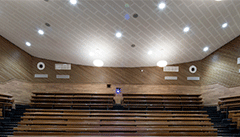
Sciences & Société
Soutenance de thèse : Wenxiang SUN
« Investigation of the thermal conductivity tuning of solid materials for energy-efficient systems using scanning thermal microscopy »
Doctorant : Wenxiang SUN
Laboratoire INSA : CETHIL
Ecole doctorale : ED162 : MEGA
One potential solution for system thermal management is to create nanostructured or nanocomposite materials, as they can exhibit a tuned thermal conductivity. Two types of materials developed in this direction were studied. They are amorphous chromium disilicide (CrSi2) thin films on substrate that were modified by implantation with neon (Ne) and aluminum (Al) ions at room temperature and at 250°C for thermoelectric applications, and bulk polymer nanocomposites where nanofillers (expanded graphite, multiwall carbon nanotubes (MWCNTs), and MXenes) are used to enhance the polymer thermal conductivity for electronic applications (as an example). Scanning thermal microscopy was used to analyze the heat conduction within both the material types as a function of their microstructure change. Estimations of the contribution of phonons and electrons to the heat conduction in CrSi2 samples obtained. These results combined with material microstructure analyses show a thermal conductivity (k) decrease of the CrSi2 for all the studied samples, more pronounced for the ion-implantation at 250°C. This decrease is attributed to implantation induced defects clusters (energy carrier scattering centers), phonon path disruption by atom mass contrast and nanocrystallites (created due to a radiation-enhanced phase transformation process at 250°C) with depletion zones for electrons at nanocrystallite boundaries. For Ne-implantations, observed Ne bubbles additionally induced by the ion-implantation also lead to phonon scattering. For polymer nanocomposites, k-measurements combined with the analyses of the material microstructure allow to verify that the introduction of carboneous fillers increases the heat conduction in materials while the filler concentration increases. A new analytical model, which allows the k-estimation in the case of MWCNTs-multiphase PVDF based composites, is proposed and results are compared with measurements. Main findings show that the β phase- PVDF, created because MWCNTs introduced in the PVDF matrix act as nucleation centers for β phase-PVDF, explains the increase of the k of the nanocomposite.
Información adicional
-
Amphithéâtre Laura Bassi (Villeurbanne)

